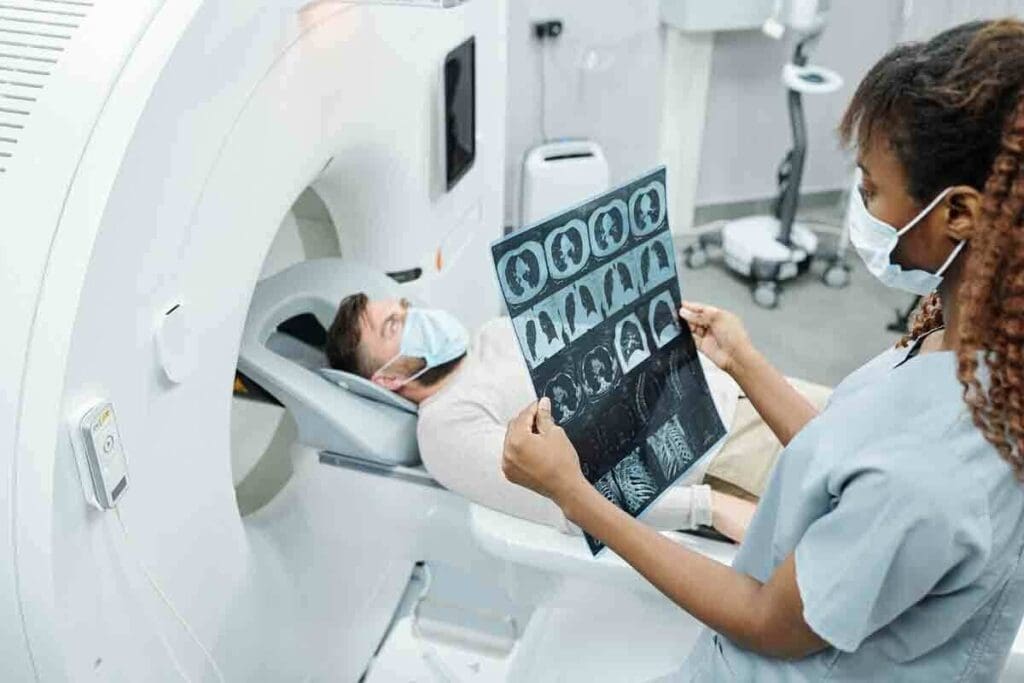Last Updated on November 27, 2025 by Bilal Hasdemir

When you’re dealing with cancer, it’s key to know about advanced tools like PET scans. At Liv Hospital, we make sure every patient gets the best care. We use the latest methods and care with kindness and precision.
A PET scan is a detailed imaging test that shows 3D pictures of your body’s inside. It uses a small amount of radioactive sugar to spot diseases early. This makes it a key tool in finding and treating cancer.
Cancer patients don’t get PET scans at the same time every time. How often depends on the cancer type, how well the treatment is working, and other health signs. Knowing when to have a PET scan is important for managing cancer well.
Key Takeaways
- PET scans are very important for finding, checking, and monitoring cancer treatment.
- How often you get a PET scan changes based on the cancer type and how well you’re responding to treatment.
- PET scans use a small amount of radioactive sugar to find diseases early.
- Liv Hospital offers full care, using the newest PET scan methods.
- Knowing about PET scans helps patients make better choices about their care.
Understanding PET Scans in Cancer Diagnosis and Treatment

PET scans are key in cancer care, giving doctors vital insights. They show how active cells are in the body. This is very helpful in fighting cancer.
What is a PET Scan and How Does it Work?
A PET scan is a test that shows how organs and tissues work. It uses a special drug that cells take in. This drug is like sugar, and cancer cells eat more of it.
This makes cancer cells show up on the scan. Doctors use PET scans for many things. They help find cancer, see how far it has spread, and check if treatment is working.
The Role of PET Scans in Cancer Management
PET scans are very important in cancer care, like in lung cancer. They help doctors know how to treat lung cancer best. Many PET scans show cancer, showing how important they are.
PET scans give detailed information on cancer spread and treatment success. They help find cancer early. This info helps doctors make the best treatment plans for each patient.
How Often Can You Have a PET Scan? Factors That Determine Frequency

Knowing how often you can have a PET scan is key to managing cancer. The need for PET scans varies based on several factors. These help doctors decide the best treatment plan for you.
Cancer Type and Stage Considerations
The type and stage of cancer affect how often you’ll have a PET scan. For example, those with stage 4 cancer might need scans more often. Aggressive cancers or those hard to treat may need scans more regularly to adjust treatment.
Different cancers need different monitoring. For instance, lung cancer might need scans more often at the start of treatment. This helps check how well the treatment is working.
| Cancer Type | Typical PET Scan Frequency | Factors Influencing Frequency |
| Lung Cancer | Every 3-6 months | Treatment response, tumor size |
| Breast Cancer | Every 6-12 months | Stage at diagnosis, treatment efficacy |
| Lymphoma | Every 2-3 cycles of chemotherapy | Response to treatment, disease stage |
Treatment Response Monitoring
Checking how well cancer responds to treatment is key. PET scans show if the cancer is shrinking, staying the same, or growing. This helps doctors adjust your treatment plan.
“PET scans provide critical information about the metabolic activity of tumors, helping us tailor treatment to the individual patient’s needs.”
— Specialists highlight.
Clinical Indications for Repeat Scans
Some clinical signs may require repeat PET scans. These include new symptoms, changes in tumor markers, or unexpected findings on other tests. Repeat scans can spot issues early, allowing for quick action.
We know getting multiple PET scans can worry patients. But the benefits of these scans in managing cancer treatment are often greater than the risks. Your healthcare team will weigh the need for each PET scan to ensure you get the best care.
Medical Guidelines for PET Scan Frequency
Medical protocols guide how often PET scans are done. They aim to find the right balance between getting needed info and avoiding risks. These rules help make sure patients get the right care without too much radiation.
Recommended Intervals Between Scans
Guidelines say PET scans should be done when needed, based on the patient’s health and treatment. The F-FDG scan gives about 7.5 mSv of radiation. PET-CT scans, which include CT scans, can give more, up to 30 mSv.
For many cancers, scans should not be repeated too soon. Usually, it’s best to wait 8-12 weeks unless there’s a good reason to check sooner. This helps see how treatment is working and keeps radiation use down.
Avoiding Unnecessary Radiation Exposure
It’s important to avoid too much radiation from PET scans. We need to think about the benefits and risks. The goal is to use PET scans wisely, only when they really help in managing a patient’s care.
Doctors follow strict rules to decide when PET scans are needed. They also look for other imaging options that don’t use radiation, like MRI or ultrasound, when they can.
By sticking to medical guidelines and using PET scans carefully, we can help patients. This way, we make sure they get the most from these scans while keeping risks low. It’s all about giving the best care to cancer patients.
Insurance Coverage and Limitations for PET Scans
Understanding insurance for PET scans can be tricky. It involves both Medicare and private insurance rules. Knowing these rules helps patients manage their cancer care better.
Insurance for PET scans varies a lot. It depends on the cancer type, its stage, and the treatment plan. This affects if a PET scan is covered.
Medicare Guidelines for PET Scan Coverage
Medicare has clear rules for PET scans, mainly for cancer patients. It covers scans for diagnosing and staging cancer. It also covers scans to check how well treatment is working.
“Medicare coverage for PET scans is typically provided when the scan is deemed medically necessary by a healthcare provider.”
-Radiologists say.
Medicare might limit PET scans if more are needed. This is unless more scans are medically necessary.
| Condition | Medicare Coverage |
| Initial Cancer Diagnosis | Covered |
| Assessing Treatment Response | Covered |
| Monitoring Recurrence | Covered with justification |
Private Insurance Policies and Restrictions
Private insurance for PET scans can differ a lot. Some policies might have stricter rules or limits than Medicare.
- Pre-authorization may be required for PET scans.
- Some insurers may limit the number of PET scans per year.
- Coverage may depend on the specific cancer type and treatment plan.
Patients should check their insurance policy and talk to their doctor. This helps understand coverage and any costs for PET scans.
How Many PET Scans Can You Have in a Year?
The number of PET scans you can have in a year depends on your cancer type and stage. It’s important to consider the benefits and risks of these scans. This helps balance the need for scans with their impact on your health.
PET scans are key for spotting cancer spread, checking how well treatments work, and watching for cancer to come back. They give doctors the info they need to plan your treatment.
Typical Annual Frequency for Different Cancer Types
The number of PET scans you can have each year depends on your cancer type and stage. For example, lung cancer patients might need more scans, like pet scans for lungs. This is to keep track of the disease and how it’s responding to treatment.
| Cancer Type | Typical Annual Frequency |
| Lung Cancer | 2-3 scans |
| Breast Cancer | 1-2 scans |
| Lymphoma | 2-4 scans |
As shown in the table, PET scan frequency varies by cancer type. For lung cancer, for instance, a PET scan on the lungs might be needed every few months. This is to check if the treatment is working.
When Multiple Scans Within a Year May Be Necessary
There are times when you might need more than one PET scan in a year. These include:
- Monitoring how well the treatment is working
- Looking for signs of cancer coming back
- Checking if cancer has spread to other areas, like the lungs, which might need a PET scan of the lungs
A study in the Journal of Clinical Oncology found that repeated PET scans are valuable. They help doctors see how treatment is going and make changes if needed.
“The use of PET scans has revolutionized cancer management. It allows for more precise and personalized treatment plans.”
— Oncologists note.
In summary, while the number of PET scans varies, they are vital in managing cancer. Knowing how often scans are needed for different cancers helps patients understand their treatment plans better.
Is There a Lifetime Limit on PET Scans?
PET scans are key in fighting cancer, but many wonder if there’s a limit to how many they can have. There isn’t a set lifetime limit, but how often PET scans are done is very important. This is to avoid any risks.
Cumulative Radiation Exposure Concerns
PET scans use ionizing radiation, with a dose of about 7.5 mSv for the PET part. This raises concerns about long-term radiation exposure and the risk of getting secondary cancers. So, doctors aim to find the right balance between using PET scans and the risks they pose.
Key considerations for cumulative radiation exposure include:
- The type and stage of cancer being treated
- The need for ongoing monitoring of treatment response
- The possibility of using other imaging methods with less or no radiation
Balancing Diagnostic Benefits and Risks
Doctors carefully choose when to use PET scans, looking at the benefits and risks. They decide if the scan will help in treating the patient.
Factors influencing this decision include:
- The patient’s overall health and medical history
- The specific characteristics of the patient’s cancer
- The chance that the PET scan will change treatment plans
By thinking about these points, doctors can reduce unnecessary radiation. This helps make PET scans more effective in managing cancer.
The Cost Factor: Why Are PET Scans So Expensive?
PET scans are very expensive, making many wonder why. The cost comes from several factors. These factors add up to the final price.
Breakdown of PET Scan Costs
The cost of a PET scan includes a few main parts. The equipment needed is very advanced and pricey. The PET scanner alone can cost millions. The facility also needs special setup to use it.
The radiopharmaceuticals used are also expensive. They are hard to make and need special care when given to patients.
Another big part is the expertise needed to do and read PET scans. Doctors must get a lot of training. This training costs money, adding to the scan’s price.
PET scans can cost thousands of dollars. The price changes based on where you get it, the type of scan, and if more tests are needed.
Financial Assistance Options for Patients
Even though PET scans are pricey, there are ways to help pay for them. Many insurance plans cover PET scans for cancer. But how much they cover can differ a lot.
If you don’t have good insurance, there are other ways to get help. Some hospitals and cancer centers offer financial aid. Non-profit groups might also give grants to help with test costs.
It’s key to talk to your doctor or a financial advisor. They can help figure out what help you might get.
PET Scans for Specific Cancer Types: Focus on Lung Cancer
PET scans are key in managing lung cancer. They help us understand the disease better. This information is vital for making treatment plans.
Initial Diagnosis and Staging
PET scans are essential for lung cancer diagnosis and staging. FDG-PET helps find the main tumor and check for spread. This info is key for planning treatment.
FDG-PET is more accurate than CT scans in finding N2 lymph nodes. This helps us stage the disease correctly. It also helps us tailor treatments to each patient.
Treatment Monitoring for Lung Cancer
After starting treatment, PET scans keep track of how well it’s working. They show if the tumor is shrinking. This helps us adjust treatments for better results.
If a tumor’s FDG uptake goes down after treatment, it’s a good sign. But if it stays the same or goes up, we might need to change our plan.
Recurrence Detection
After treatment, lung cancer patients need regular checks for signs of recurrence. PET scans are great for catching this early. Early detection means we can act fast and possibly save lives.
We suggest regular PET scans for follow-up. How often depends on the patient’s risk and health status.
| Application | Benefits | Clinical Utility |
| Initial Diagnosis and Staging | Accurate assessment of disease extent guides treatment planning | High sensitivity and accuracy in detecting N2 lymph nodes |
| Treatment Monitoring | Assesses treatment response, informs adjustments to therapy | Evaluates changes in tumor metabolic activity |
| Recurrence Detection | Early detection of recurrent disease enables timely intervention | Critical for improving outcomes in patients with recurrent lung cancer |
Conclusion: Making Informed Decisions About PET Scan Frequency
Knowing how often you can have a PET scan is key to good cancer care. We’ve talked about what affects how often you get a PET scan. This includes the type of cancer, how well treatment works, and when a scan is needed.
Guidelines suggest that PET scan frequency should match each patient’s needs. Some patients might have several scans in a year. Studies show that about 20.9% of patients have two or more 18F-FDG PET/CT scans in a year. The most common cancers for these scans are melanoma, non-Hodgkin’s lymphoma, and gastrointestinal cancer.
It’s important to follow medical guidelines to balance the benefits and risks of PET scans. This includes thinking about how much radiation you get. For more details, check out studies on National Center for Biotechnology Information.
By knowing what affects PET scan frequency, we can make better choices for our care. This helps us get the right tests without too much radiation.
FAQ
How often do cancer patients get PET scans?
The number of PET scans for cancer patients varies. It depends on the cancer type, stage, and treatment response. We decide based on each patient’s needs and medical guidelines.
How many PET scans can you have in a year?
The number of PET scans in a year varies. It depends on the cancer type, treatment plan, and how the patient responds. We follow guidelines to avoid too much radiation.
Why are PET scans so expensive?
PET scans are expensive because of the cost of equipment, radiopharmaceuticals, and expertise. We help patients find financial help.
What percentage of PET scans are positive for cancer?
The percentage of PET scans showing cancer varies. It depends on the patient population, cancer type, and context. We use PET scans as one tool to diagnose and manage cancer.
Does a PET scan show lung cancer?
Yes, PET scans can show lung cancer by highlighting active areas. We use them with other tools to manage lung cancer.
Why would a doctor recommend a PET scan?
Doctors recommend PET scans to diagnose and stage cancer, monitor treatment, and detect recurrence. The decision is based on individual patient needs.
What are the dangers of a PET scan?
PET scans are generally safe but involve radiation exposure. We consider the benefits and risks for each patient.
How often can you have a PET scan?
PET scan frequency varies based on cancer type, treatment response, and clinical indications. We use them judiciously and safely.
Is there a lifetime limit on PET scans?
There’s no strict lifetime limit on PET scans. We consider cumulative radiation exposure. The decision to perform a PET scan is made on a case-by-case basis.
Can PET scans detect lung cancer recurrence?
Yes, PET scans can detect lung cancer recurrence by showing increased metabolic activity. We use them in follow-up plans to monitor for recurrence.
References
Herscovitch, P., & Delbeke, D. (2022). Regulatory agencies and PET/CT imaging in the clinic. PMC. https://www.ncbi.nlm.nih.gov/pmc/articles/PMC9340745/






